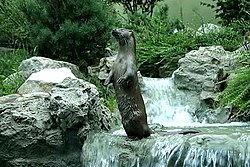Lutrinae
The lutrinos (Lutrinae), commonly known as otters, are a subfamily of carnivorous mammals of the large family Mustelidae. There are thirteen species of otters divided into seven genera, with a practically worldwide population distribution. In certain regions of South America it is common for another animal to be called "otter", the coypu or quiyá (Myocastor coypus), with predominantly aquatic habits, but which is a rodent.
Features
They have thick, waterproof fur that allows them to retain their body heat. They are great swimmers and can close their nostrils underwater, being able to stay underwater for up to four minutes without surfacing to breathe. They move their legs and tail, up and down, when they move through the water at high speed. They only use their front legs when swimming slowly. In the water they can reach speeds of up to 12 km/h.
Natural history
Otters come into heat at any time of the year; however, its reproduction is slow and irregular, although more births are observed during the spring. Two or three pups can result from each of them, which are born blind and toothless. Their lactation period is about two months, leaving the maternal territory after approximately one year, when they begin to wander in search of establishing their own territory, which they do approximately two years after being born.
River otters feed on small fish, frogs, and other aquatic animals that they catch in their mouths. In contrast, tropical otters from Asia and Africa dig in the mud at the bottom of rivers with their sensitive front feet in search of food (shrimps, crabs, and the like).
Off the western coast of North America live sea otters that catch their prey with their front feet: slow-moving fish and shelly animals such as sea urchins and mollusks. The use of tools is attributed to this animal, since they take a stone from the bottom of the sea and, swimming upside down, place it on their chest and hit the mussels until they break, being, in addition to primates, one of the few mammals that they use some kind of "tool". It is an endangered animal, so in many places its hunting is prohibited. Its natural predator is the orca.
In Argentina, Colombia, Brazil, Ecuador, Guyana, Venezuela, Paraguay, Uruguay and also Peru, there is a species of large otter, the giant otter (Pteronura brasiliensis), which reaches measure about 2 m and weigh between 35 and 40 kg. Their fur is brown and very bushy, which made them especially desirable by hunters. It feeds exclusively on fish that it hunts in groups of two to five individuals. It lives in family groups, usually the reproducers, the cubs and the almost adults. The latter collaborate in raising the pups, but do not reproduce until they leave the family group. The Spanish conquistadors nicknamed them "rio lobos". Their common habitat is usually the Amazon River basin and the Orinoco River and they are, together with the jaguar, the black caiman, the anaconda and the harpy eagle, one of the top predators in South America. This species is found in some of the rivers to the north of Argentina, but not in Uruguay where its extinction has been avoided through hatcheries. In Peru, work began to protect the last otter discovered in danger of extinction in the city of Arequipa in the town of Ayo Castilla.
Its physiognomy adapted to an aquatic life, presents a convergent evolution with Puijila darwini (the ancestor of seals and sea lions), and to a lesser extent with Coipo.
Being mammals that spend most of their time in the water (even when sleeping), they hold hands to prevent the current from dragging them away from the group. In this way, sea otters ensure that they are not going to wake up on their own. Otters are intelligent and affectionate animals. They use tools for different purposes; to procure food, play, protect themselves.
Taxonomy
- Gender Aonyx
- Aonyx capensis
- Aonyx cinereus
- Gender Enhydra
- Enhydra lutris
- Gender Hydrictis
- Hydrictis maculicollis
- Gender Lontra
- Lontra canadensis
- Lontra felina
- Lontra longicaudis
- Lontra provocax
- Gender Lutra
- Lutra lutra
- †Lutra nippon
- Lutra sumatrana
- Gender Lutrogale
- Lutrogale perspicillata
- Gender Pteronura
- Pteronura brasiliensis
In addition, the following extinct genera are known:
- †Algarolutra
- †Cyrnaonyx
- †Megalenhydris
- †Sardolutra
Contenido relacionado
Hemicellulose
Leptin
Progesterone



